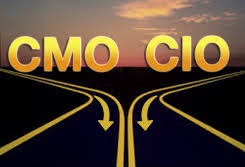A recent IDC white paper reveals how the use of mobile devices is pervasive in society and that the number of smartphones and tablets shipped worldwide is expected to exceed 2 billion by 2017. Both Gartner and IDC have pointed out how mobility is causing challenges or friction between IT organizations and their line of business owners making it hard to align the goals of the two groups. This problem is frequently visible between Chief Information Officers (CIOs) and Chief Marketing Officers (CMOs). 
As one CIO.com article points out, “The CMO needs to develop a vision and strategy for how customers experience the brand, while the CIO needs to deliver the tools and technology to bring those experiences and campaigns to life.” Additionally, a recent survey from the Altimeter Group indicates that “chief marketing officers are twice as likely to be driving digital transformation efforts as chief information officers. A full 54 percent of survey respondents identified the CMO as the digital transformation leader, while only 29 percent cited the CIO or chief technology officer and 42 percent identified the CEO.”
Another CIO.com article refers to the CIO-CMO relationship as an arranged marriage in that one in four CIOs believe CMOs lack the vision to anticipate new digital marketing channels, while many CMOs say that CIOs lack the urgency in responding to shifting marketing conditions. A recent Accenture survey of CMOs and CIOs that ranks their department’s priorities highlights their disagreements.
The main problem appears to be the speed of solution delivery within a fluid environment. 43% of CMOs say the technology development process is too slow. Interestingly, 43% of CIOs say that marketing requirements and priorities change too quickly. Marketing or IT project problems have risen from 36 to 44% in the past year. One area of agreement is that both groups (42%) say technology is too siloed. 43 percent of CMOs and 50 percent of CIOs say they’re working more collaboratively but only 1 in 4 respondents say collaboration is currently at the right level.
The IDC whitepaper exposes that more holistic mobile-first development practices are seeing positive results. The survey finds that companies taking an enterprise lead approach to mobility rated their satisfaction with these deployments higher than companies with a business unit led or departmental led approach. They recommend that companies adopt a mobile-led strategy that is supported from the very top of the organization (e.g. CIOs and CMOs). As this article points out, “The top five benefits from digital transformation are a lift in customer engagement (75 percent), improved customer satisfaction (63 percent), higher traffic (53 percent), increased lead generation and sales (49 percent) and greater conversions (46 percent). The key to digital transformation is to adopt technology as an enabler for something bigger.”
We’ve seen the companies who choose a SaaS-based mobile engagement platform that meets IT’s approval and is flexible to quickly create solutions used by marketing, customer service, human resources, and business operations as an example of this enabler technology. It’s clear that a single platform approach can achieve the kinds of business outcomes that CIOs and CMOs desire whether it’s higher ROI, better customer engagement, competitive differentiation, or increased customer satisfaction. For these reasons, CIOs and CMOs should start silo smashing today!
Contact OpenMarket to learn how we can help you resolve different perspectives within your organization by using a single mobile engagement platform approach.
